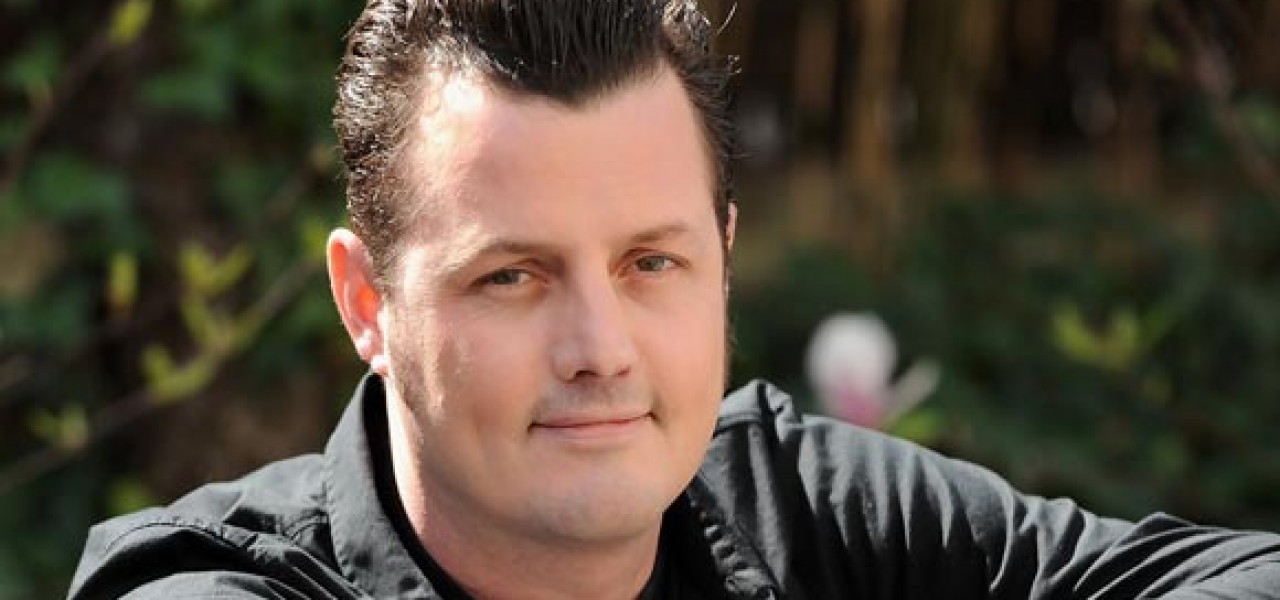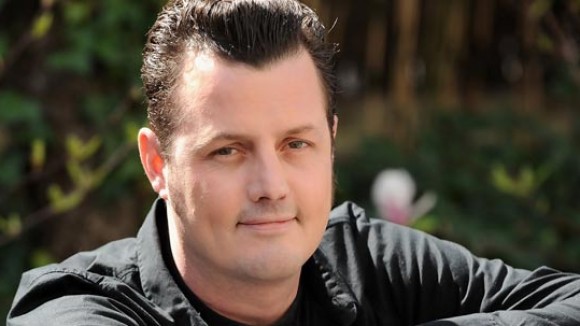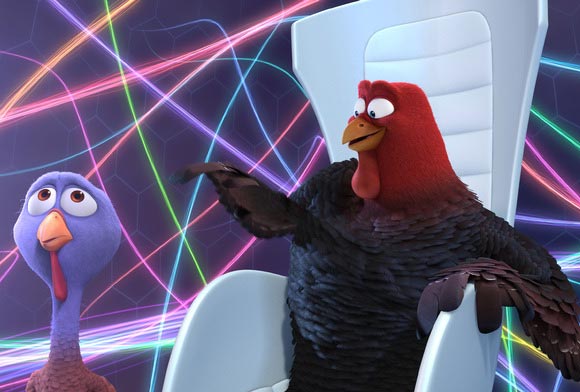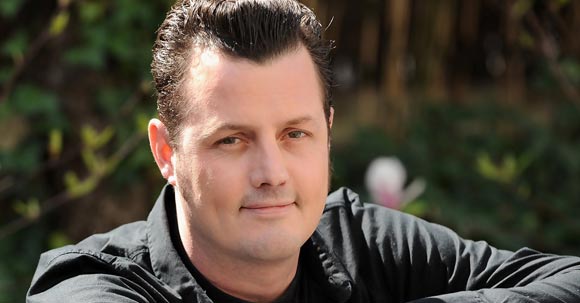

Director Jimmy Hayward Talks “Free Birds”

Earlier this month, Dallas-headquartered Reel FX released their first animated feature Free Birds. Over its first three weekends in theaters, the holiday-themed children’s film has earned a respectable $42 million, and it will pad that number even further during the upcoming Thanksgiving holiday.
Only 43 years old, the film’s director, Jimmy Hayward, is an industry veteran with over twenty years of industry experience. He was an animator on the pioneering computer animated TV series Reboot, and then animated on the first-ever CG animated feature, Pixar’s Toy Story. He animated for a decade on Pixar films such as A Bug’s Life, Monsters Inc. and Finding Nemo, before joining Blue Sky Studios to work as a writer and sequence director on Robots. His directorial debut was Blue Sky’s hit Horton Hears a Who! (2008). He then directed the live-action film Jonah Hex (2010) before joining Reel FX to helm Free Birds.
I recently had a spirited and free-ranging conversation with Jimmy about the making of Free Birds. He opened up the challenges of making a film at a studio that has never produced a feature, discussed why so many animation directors are moving into live-action filmmaking, and offered advice for animators who want to become directors.

Cartoon Brew: Free Birds originally had a different director—Ash Brannon—attached to it. When and how did you become involved with the project?
Jimmy Hayward: I became involved about two and a half years ago. Like a lot of animated movies, it had a winding path to getting made. How did I become involved? I talked to Craig Mazin, who had written a draft of the script that Scott Mosier and I rewrote. Reel FX was really trying to get this movie made. I think they took a couple cracks at it, and at the point that I came along, they wanted to reconceive it.
Cartoon Brew: What stage was the film in storywise? Was it the same story or did you make changes to it?
Jimmy Hayward: Absolutely, we completely changed the story. They’d done artwork, and they’d storyboarded some things. They did some pre-production. And we redid it. When a film is in development, you’re developing things, and they were at a place where they wanted to redo it. With all animated features, you never really make a script. It’s not like a shooting script where you have to prep that script and do exactly what’s in that script. Animated movies are made in the story department and the animation department. That’s where all the comedy comes from and that’s where the story really develops and gets built. We brought in a new character designer, new art director. It was like a whole new thing.
Cartoon Brew: And there were no actors attached at that point, correct?
Jimmy Hayward: Woody [Harrelson] and Owen [Wilson] were the only actors that were attached. Woody and Owen are friends with the owner of Reel FX and they all wanted to do a movie together for a long time. That trio of people—Tom K. and Owen and Woody—was the catalyst for making it happen. Other than that though, all the other cast, all the other dialogue, was redone. Not even redone. I came onto a movie where there was an existing script and I started making a movie. It wasn’t like it was half-done and I picked it up.
Cartoon Brew: But the concept of time-traveling turkeys was there?
Jimmy Hayward: Oh yeah, [John J.] Strauss and [David I.] Stern who are executive producers on the movie had written a script that Reel FX worked with, and we kept the original premise completely: two turkeys go back in time to try and get turkey off the menu.
Cartoon Brew: You mentioned the owner of Reel FX. That’s the businessman Tom Kartsotis, who also owns Fossil Watches, right?
Jimmy Hayward: He’s a great dude. He’s a gutsy, awesome guy. He really stuck to that studio and stuck to the idea that they’d make feature films, and he’s done it.
Cartoon Brew: Does he have any involvement in the day-to-day or does he take a hands-off approach to the studio?
Jimmy Hayward: Completely hands off. He always says, “I don’t know anything about making movies. You guys make the movies.”
Cartoon Brew: That’s what you want!
Jimmy Hayward: Yeah, he’s a lot like Steve Jobs was to Pixar. He was a person that was very successful in another business and saw big potential in a talented group of people that really had a passion to do something. He recognized that and backed it. A lot of the same spirit [as Pixar]. I’m not saying it’s the same company or anything’s the same, just that it’s a lot of the same spirit in that he was awesome enough to put his money behind it and let it go.
Cartoon Brew: That sounds like Nike CEO Phil Knight at LAIKA, too.
Jimmy Hayward: Yeah, exactly like Phil Knight.
Cartoon Brew: You directed Jonah Hex, a live-action film in between Horton Hears a Who! and Free Birds. So many animation directors are moving into live-action nowadays—Henry Selick, Brad Bird, Andrew Stanton, Chris Wedge and Carlos Saldanha at Blue Sky are both getting ready. Are the skill sets transferable and what did live-action teach you when you came back to animation?
Jimmy Hayward: Well, I have always made live-action movies. I’ve made both since I was a kid. Even when I was an animator at Pixar, I was shooting 35mm shorts. I’ve always made skate videos, always been doing that kind of stuff. So, for me, personally, it was something I wanted to do since I was young.
We’re all filmmakers; we’re all people that like to make stuff. It’s an exciting challenge for people to want to do. People have varying levels of success with it. [laughs] But I think from the outside, it might be easy to look at and say, ‘Oh, you’re just abandoning art form,’ or ‘It’s cooler to direct live-action.’ All of us have different reasons. For me, it’s just another way to make stuff, challenge yourself and try to tell different stories.
For a situation like Hex, no matter how it turned out, it was a property that I loved when I was a kid and it was something that I jumped at the chance to do and it seemed to make sense at the time. I continue to write and develop both live-action and animated properties because I’ve always been into doing that. I just want to make cool stuff. With Reel FX, it was an opportunity to work with a studio that was making their first feature which is exciting and awesome and fun, and I had a lot to bring to the table.
We all manage our careers in different ways. I’m sure Andrew [Stanton] will make more live-action movies in the future; hopefully Brad [Bird] will do more animation in the future because he’s awesome at it. And you look at [Guillermo] del Toro. He’s a live-action guy. He’s also been working at DreamWorks doing animation, and now he’s doing Jorge Gutierrez’s movie over at Reel FX.
Skill sets are smashing together because there’s so much CG used in live-action. And when you work with actors in a recording studio, getting a performance out of an actor is very similar. The difference is that in live-action, the chemistry has to happen on the set, and in animation we have to completely create it from scratch because we record the actors separately. But at the end of the day, it’s all putting a bunch of stuff together to entertain an audience…or not entertain an audience, depending on how it goes.
Cartoon Brew: Who’s more difficult to deal with…actors or animators. Remember, there’s only one right answer for this site.
Jimmy Hayward: The process of working with animators is one of my favorite things to do. Having an understanding of what a scene is going to be, and then giving somebody the opportunity to go away and come up with a better way of doing it and seeing the results of that, it’s like Christmas everyday. Because all these talented, intelligent people are coming back to you with all these new angles. And that process is vastly different than working with an actor trying to get a performance out of them. You’re still listening to their ideas and all that stuff, but it’s a totally different thing. I wouldn’t say negatively one’s worse to work with than the other, but I definitely love the process of working with the animator.
Cartoon Brew: Was it more difficult to do a film at a studio that didn’t have a feature pipeline, and did that impact how you directed?
Jimmy Hayward: A little bit. I think having some people with me that I’d done it with before. Rich McKain came from Pixar to supervise the animation. Chris DiGiovanni—Mad Dog—who was the animation manager at Pixar, has worked with me on movies like Horton Hears a Who! A lot of the people that came on with me helped that process along, and there was a bunch of great talented people there already, of course. The main difference between making a feature film from script to screen, and doing [service] work on other projects is that there has to be a unilateral component to the pipeline where when things change upstream, you can go back downstream and fix them so that the whole thing sticks together.
The biggest trick in making that leap is the understanding that the story changes not just a little bit, but all the time. A certain director I worked for when I was a young fellow who’s massively successful and runs a huge studio now said the greatest components of a film come together in the last five per cent. If you see an opportunity to make it better, you have to be nimble enough to do it. The idea is you have to be open to the constant changing and I think the guys at Reel FX did a great job of adapting themselves to that and now have that pipeline in place—the way you report production issues, the way you track changes and fixes. The only thing that changed anything for me is that I would get a little bit more involved in producing stuff than I would normally have to, but that was fine because it was all in the name of creating this engine that you could put stories through.
Cartoon Brew: The film looks very rich for the budget it was made on, which is a fraction of what other major studios spend on their films. I’m curious, how were you able to streamline the production and economize to create a film that looks like this on your budget?
Jimmy Hayward: Some of that comes from Scott Mosier and myself writing and making the film together, and then having Aron Warner as the head of animation at Reel FX. Not having to go through a long winding process of approvals was paramount in getting it done.
Also, creating some new ways of working was the key to making the movie at a level of quality that defies budget. The animators did a lot of video reference. I’d give them 24 hours to come back and show me what they were going to do. Rather than an animator going off and blocking for three or four days and showing me something that wasn’t going to work, we had a room where we’d shoot green screen shots. You got the characters staged in a frame the way the animated characters were supposed to be, and they’d act it out to the voice track. And then they’d use frame skipping and cutting techniques to blend together five or ten different performances to get the exact thing they wanted. And we got back hilarious and amazing stuff from that, and then when they had that clip, they’d animate to that. I didn’t demand everybody use it, but I really encouraged people to use it because we got such excellent results. And what happened, a few of the animators wound up becoming sort of almost like the acting cast for video reference and it worked out great for the emotive scenes. It really opens up this incredible new opportunity for us to get higher quality stuff much faster than going down a hundred different rabbit holes trying to figure out what something’s going to be.
Cartoon Brew: I recently wrote a biography of Ward Kimball, who designed Jiminy Cricket in Pinocchio, and he often discussed the evolution of that character from a realistic cricket into what essentially became a little man in a top hat. But you tell audiences Jiminy is a cricket, and that’s what he was. In your film, they’re clearly turkeys, but they lack the grotesque characteristics of real turkeys and don’t move like turkeys. How many iterations did you go through before arriving at the final designs and what were the essential elements for making them turkey-like?
Jimmy Hayward: I didn’t really want them to be like people in rubber suits, and they’re not really. The way they hold their wrist is more wing-like and I think the transition between wings to hands was a really big trick. But I agree with Ward in that what really matters is the feel. And that goes both ways. I think Rango’s really appealing but he still walks around like a man sometimes and sometimes acts like a lizard. With the turkeys, it’s the same thing. Because the movie’s told from their perspective, it’s ok if they appear more human-like when we need to, like they need to push buttons or climb a ladder. But also when they’re in panic mode, a lot of times they flap their wings. So we made specific choices about that. But yeah, you’re right. Turkeys are ugly. They look like melted candles. They have dangling bits of fat hanging off their faces and they look like they’re diseased so that wasn’t going to work.
One of the first things I approached with the design was the eye language. Audiences are looking at eyes most of the time. So getting the eye language between all the species and characters to line up, and the structure around their faces [was important]. I think it’s really important that the audience has something appealing to look at for the movie.
Cartoon Brew: Speaking of eyes, there’s a running gag with the character Jenny where her pupil falls out of its socket. It’s one of the weirdest gags I’ve seen in an animated film, and it was both funny and uncomfortable at the same time. What was the thinking behind that idea?
Jimmy Hayward: The fact that she had a funny eye came in a different form from Craig Mazin, the writer. The idea was that Reggie was a shallow guy on the surface, but actually he liked her for who she was even though she had this funny eye. It’s really difficult to play that off in a movie. I put in a version where it falls out the first time, and Jake makes fun of her because of it, and it was kind of repulsive and not cool. Amy Poehler and I talked a lot about it. I sent her an email at one point and said, “I think I’m going to take it out,” and she said, “I’m really bummed about that. I thought that was really cool.”
And then I realized it was all about how the other characters reacted to it that made it either cute and funny or offputting. So we changed it so that nobody else says anything about it and it only kind of happens when Reggie’s around, and when it happens, it doesn’t faze him at all. He loves her just the way she is. It makes her a stronger character that she doesn’t even worry about it: her eye falls out of the socket and she rolls it back into place like nothing happened. I think girls really connect with it and think it’s funny.
Cartoon Brew: You’re right, no one else really reacts to it in the film. It’s only between Reggie and her, but it’s not a group thing where everybody piles onto her.
Jimmy Hayward: There used to be a line of dialogue in there where Jake says to Reggie, “You like the 400-year-old turkey with the crazy eyeball?” It was a great line, but I had to cut that.
Cartoon Brew: That was an actual line?
Jimmy Hayward: Yeah! [laughs] There was a lot of stuff that I really regret cutting out of this movie. There’s some big out loud laughs that Scott, Aron and I all together loved so very dearly [but] that people had trepidation about offending people.
Cartoon Brew: That leads into my next question: The film’s assistant director Chris DiGiovanni said in an interview that there’s a director’s cut which he hopes people will someday see.
Jimmy Hayward: He said that? [laughter]
Cartoon Brew: I’m not sure if he was supposed to say that, but he did. [laughter] So I’m curious, what kind of stuff did you want to have in the film that was cut out?
Jimmy Hayward: One of the things Scott [Mosier] and I tried to do was put jokes in for adults because the people that sit and watch the movies with kids can be bored sometimes. Scott and I also have a bizarre sense of humor between us, and we had a bunch of material where we wanted to push the edge and see where it was. And we tested it and people laughed their heads and then at the end were like, ‘How dare you!’ because little kids saw it. It wasn’t even that gnarly, but I think we pulled it back too far in some very specific places.
There’s one point in the movie where Jake and Reggie first meet where Jake tackles Reggie, lays on top of him, and says, “I don’t know who you are but you’re seriously jeopardizing this mission!” Reggie’s like, “Are you crazy, it’s me.” Then, you cut to this close-up of Jake and he’s studying Reggie’s eyes. You cut back to Reggie uncomfortably looking at him. You cut back to Jake and he goes, “You have really nice eyes.” And Reggie is like, “Yea, thanks, could you get off me.” Then, Jake, without blinking, goes, “Why.” And even me pitching it doesn’t seem that funny, but in the execution and the animation, it was hilarious. It was supposed to be a personal space joke because Jake has no sense of personal space, which was a running gag. It made audiences laugh out loud but some people really took it the wrong way.
Cartoon Brew: Who took it the wrong way though— the distributors?
Jimmy Hayward: It’s just test audiences. We tried all kinds of stuff with test audiences.
Cartoon Brew: Are test audiences an important part of the process for you?
Jimmy Hayward: I think in the movie business of today, yes. In the movie business of today where money is much harder to come by and studios don’t take that many risks—it’s one of those things where you want to make sure that someone goes and sees your movie.
There’s a death in the movie and every test audience I showed this movie to said that was their least favorite part of the movie. And my argument was, “Good…that’s the point…make people cry…it’s good to have an emotional experience in a movie.” That’s the kind of thing where the audience all said it was something that they didn’t like, but that just made me want it in the movie even more. It’s not like we test it, and the audience says they don’t like things and we just let them take it out. Really, the best thing about testing a movie is to figure out where the flat spots are and also figure out the distance behind jokes. So if you have a joke in there and the audience laughs at it, you don’t run over the next line of dialogue that’s important to the story…it helps you pace things.
Cartoon Brew: You made the leap from animating to directing in your mid-’30s. What advice do you have for someone who wants to transition from animation to direction?
Jimmy Hayward: For me personally, it was making things outside of the studio. When I was at Pixar, I was making music videos and film before I got there and the whole time I was working there. I’m always working on side projects. I’m in Florida right now to play with my band. I play music, I make movies. To me, it’s about developing your skillset past just that [single] thing. Look, I’m a good animator’s director because I used to be an animator for a long time. What you need to do as a director is to get your idea across to all these different people and all these different departments in their language. So it’s important to know a lot of stuff about the process.
Some people have different approaches to it, but for me, it’s a leadership job. It’s a job where you have to motivate people to see things your way. I think having a healthy respect for all the other departments is a great start. At this point, technology is so easy to get…if I had all these tools when I was a kid, I can’t even imagine what crazy shit I would’ve made. It’s so easy now to make a short film on your own. That’s my advice to young animators who want to be directors: make movies.

